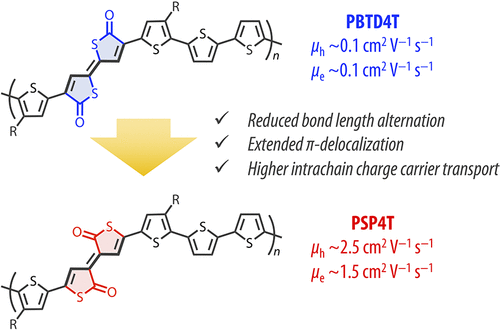当前位置:
X-MOL 学术
›
Chem. Mater.
›
论文详情
Our official English website, www.x-mol.net, welcomes your
feedback! (Note: you will need to create a separate account there.)
Extended π-Electron Delocalization in Quinoid-Based Conjugated Polymers Boosts Intrachain Charge Carrier Transport
Chemistry of Materials ( IF 7.2 ) Pub Date : 2021-10-21 , DOI: 10.1021/acs.chemmater.1c02072 Tsubasa Mikie 1, 2 , Masahiro Hayakawa 3, 4 , Kenta Okamoto 1 , Keitaro Iguchi 2 , Shuhei Yashiro 5 , Tomoyuki Koganezawa 6 , Masatomo Sumiya 5 , Hiroyuki Ishii 7, 8 , Shigehiro Yamaguchi 4, 9 , Aiko Fukazawa 3 , Itaru Osaka 1, 2
Chemistry of Materials ( IF 7.2 ) Pub Date : 2021-10-21 , DOI: 10.1021/acs.chemmater.1c02072 Tsubasa Mikie 1, 2 , Masahiro Hayakawa 3, 4 , Kenta Okamoto 1 , Keitaro Iguchi 2 , Shuhei Yashiro 5 , Tomoyuki Koganezawa 6 , Masatomo Sumiya 5 , Hiroyuki Ishii 7, 8 , Shigehiro Yamaguchi 4, 9 , Aiko Fukazawa 3 , Itaru Osaka 1, 2
Affiliation

|
Over the past two decades, the charge carrier mobility of π-conjugated polymers has vastly improved. This has been mostly achieved by increasing the π–π stacking ability of the polymers through advanced molecular design, thereby improving “interchain” charge carrier transport. However, the rational design of π-conjugated polymers for improving “intrachain” charge carrier transport along the backbone still remains a formidable challenge. Here, we show the synthesis of a new π-conjugated polymer based on a quinoidal bithiophene moiety (PSP4T), which interestingly, was found to have significantly extended π-electron delocalization along the backbone compared to its isomer (PBTD4T), although these polymers have an identical basic structure. Importantly, despite the similar π–π stacking structure, PSP4T demonstrated transistor mobilities of around 1–2.5 cm2 V–1 s–1 that are 1–2 orders of magnitude higher than that of PBTD4T. On the basis of further investigations of energetic disorder and theoretical simulations, the higher mobility in PSP4T than in PBTD4T is most likely attributed to the remarkably higher intrachain charge carrier transport, which originates in the highly extended π-electron delocalization. We believe that our study can provide new guidelines for the design of π-conjugated polymers with high intrachain charge carrier transport.
中文翻译:

基于醌的共轭聚合物中扩展的π-电子离域促进链内电荷载体传输
在过去的二十年里,π-共轭聚合物的电荷载流子迁移率得到了极大的提高。这主要是通过先进的分子设计提高聚合物的 π-π 堆积能力来实现的,从而改善“链间”电荷载流子传输。然而,用于改善沿主链的“链内”电荷载流子传输的π共轭聚合物的合理设计仍然是一个艰巨的挑战。在这里,我们展示了基于醌型联噻吩部分 ( PSP4T )的新型 π 共轭聚合物的合成,有趣的是,与其异构体 ( PBTD4T)相比,该聚合物沿骨架显着扩展了 π 电子离域。),尽管这些聚合物具有相同的基本结构。重要的是,尽管具有类似的 π–π 堆叠结构,PSP4T表现出的晶体管迁移率约为 1–2.5 cm 2 V –1 s –1,比PBTD4T高 1–2 个数量级。根据对能量无序和理论模拟的进一步研究,PSP4T 的迁移率高于PBTD4T最有可能归因于显着更高的链内电荷载流子传输,这源于高度扩展的 π 电子离域。我们相信我们的研究可以为具有高链内电荷载流子传输的 π 共轭聚合物的设计提供新的指导。
更新日期:2021-11-09
中文翻译:

基于醌的共轭聚合物中扩展的π-电子离域促进链内电荷载体传输
在过去的二十年里,π-共轭聚合物的电荷载流子迁移率得到了极大的提高。这主要是通过先进的分子设计提高聚合物的 π-π 堆积能力来实现的,从而改善“链间”电荷载流子传输。然而,用于改善沿主链的“链内”电荷载流子传输的π共轭聚合物的合理设计仍然是一个艰巨的挑战。在这里,我们展示了基于醌型联噻吩部分 ( PSP4T )的新型 π 共轭聚合物的合成,有趣的是,与其异构体 ( PBTD4T)相比,该聚合物沿骨架显着扩展了 π 电子离域。),尽管这些聚合物具有相同的基本结构。重要的是,尽管具有类似的 π–π 堆叠结构,PSP4T表现出的晶体管迁移率约为 1–2.5 cm 2 V –1 s –1,比PBTD4T高 1–2 个数量级。根据对能量无序和理论模拟的进一步研究,PSP4T 的迁移率高于PBTD4T最有可能归因于显着更高的链内电荷载流子传输,这源于高度扩展的 π 电子离域。我们相信我们的研究可以为具有高链内电荷载流子传输的 π 共轭聚合物的设计提供新的指导。











































 京公网安备 11010802027423号
京公网安备 11010802027423号